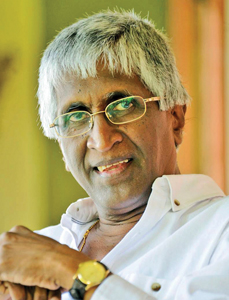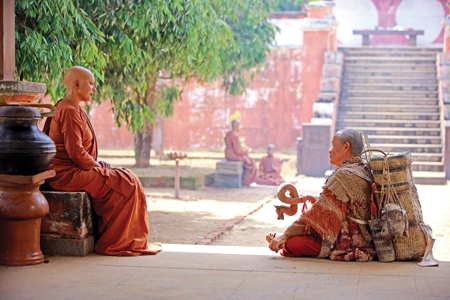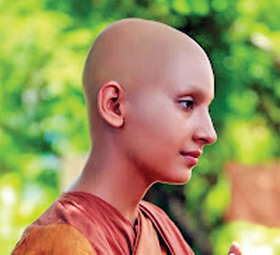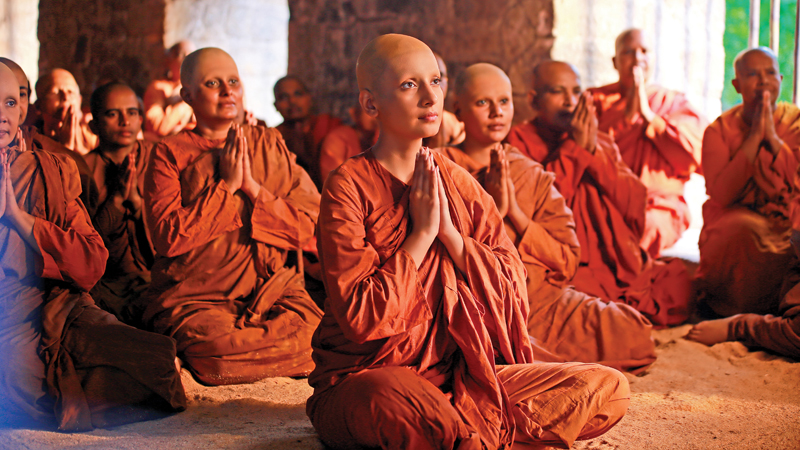Having had the chance to see Prof. Sunil Ariyaratne’s latest Sinhala movie titled Gauthama Buddha Matha, I had the inner inclination to jot down the following factors pertaining to the topic that lingers in my mind. Initially, I felt that a series of sensitive creative areas ensue in the entire work. They go into the making of an exemplary profile of motherhood. The story, as depicted traditionally, is well known.

Prof. Sunil Ariyaratne
It is none other than the profile of Prajapathi Gotami the Great, traditionally known as the foster mother to Siddhartha Gauthama. Referring to Prajapathi as Siddhartha’s second mother seems more fitting as it conveys her deep maternal involvement in the prince’s life.
A portrait of an extraordinary woman who dedicates her life to caring for Siddhartha, from his infancy to his renunciation, following the passing of Mahamaya, the Queen Consort of King Suddhodhana, Siddhartha’s father.
The underlying story is known by the whole world, especially those living in Buddhist cultures, and its influential areas of existence, known as oriental.
The age-old narrative of the Sakya clan is written and rewritten in several other cultures as well, enhancing other forms of creativity. Two good examples are observable: Hermann Hesse’s Siddhartha and Edwin Arnold’s celebrated poetic work The Light of Asia.
Research efforts
Prof. Sunil Ariyaratne, in order to fulfil his creativity, seems to have left no stone unturned in his research efforts to seek essential ingredients for his creativity. These background research materials cover the sources drawn from:
* Religious and spiritual areas,
* Historical sources,
* Sociological and anthropological sources.
The long list of sources is lined up to brief the effort to the spectator.
 In this effort, one rarely observed event is declared. That is, strangely enough, the meeting of the well-known Chinese explorer Fa Hsien and a Buddhist nun. Their encounter exemplifies all the events of a sacred profile. The event leads to the understanding of all the possible ventures of the Siddhartha’s second mother, as well as the events that lead the prince to renounce worldly life. This is an explorative dialogue.
In this effort, one rarely observed event is declared. That is, strangely enough, the meeting of the well-known Chinese explorer Fa Hsien and a Buddhist nun. Their encounter exemplifies all the events of a sacred profile. The event leads to the understanding of all the possible ventures of the Siddhartha’s second mother, as well as the events that lead the prince to renounce worldly life. This is an explorative dialogue.
This explorative dialogue, or the meeting point, is treated by Ariyaratne not as a tradition-bound storytelling pattern but as an enlightening way for a better creative communication pattern, retaining several salient and more modern creative patterns that amalgamate the fantasy and the reality, plus the aesthetic beauty in visuals that may possibly uncover latent creative visions.
The enlightening dialogues act either as a prologue to an oncoming human episode or a series of episodes that lead to a dance recital or a song, packed with a prophetic vision. One good example is the song containing a series of metaphysical visions of an inner joy of Kalo Ayante (‘Time is for you now’). It is a song of inner clamour praising a noble person or a Maha Purusha.
Lyrical example
The following lyrics (translated into English by this writer) are a classic example.
The teardrops of beloved separation, from eye to eye,
Sorrows burn, heart to heart.
In the infinite affection,
In the immaculate love across Samsara,
In the fragrance of milk upon the newborn’s breath.
Cast those memories away,
O Great Being,
Time is for you now
To move on
Can a man, irrespective of his power, clan, and nobility, be happy? Siddhartha happened to be the Great One as he understood what is meant by happiness.
He was a truth-seeker who abandoned all worldly pleasures. How to find the real truth happened to be his main mission, which created an order of followers. He admitted males as his followers.
 But a time came when he had to listen to his second mother, Prajapati Gotami the Great, to accept females too as his followers. A galaxy of females was in need of joining the order of nuns thus formed, amidst several obstacles.
But a time came when he had to listen to his second mother, Prajapati Gotami the Great, to accept females too as his followers. A galaxy of females was in need of joining the order of nuns thus formed, amidst several obstacles.
As depicted in the well-known Buddhist narratives, the portrait of Chinchi Manavika (the maiden known as Chinchi), who was desirous of poking fun at the Buddha, also emerges, evoking a certain sense of humour that could be branded as humane humour. Ariyaratne is quite careful in refraining from giving an overdose of this type for the sake of mere laughter. This is the essence of creative thinking.
This sense of creative thinking, in terms of visuals on the part of Ariyaratne, also leads to a bright side of cine aesthetics and the allied elements of beauty, denoted as ‘aesthetic beauty in visuals,’ taught by researchers of the calibre of Dr. Ananda Coomaraswamy in The Dance of Shiva and several other learned presentations. Aesthetic beauty in visuals goes a long way in paintings and sculpture, where the observer-cum-seeker becomes a recipient of an extra dimension of seeking into existence.
Delightful wisdom
The spectator is no longer a person whose sensory faculties were enriched by mere entertainment. Instead, it is believed that he or she has entered a world, as the poet Robert Frost cited, ‘a world from delight to wisdom’. The delight in this context is the mere seeing. But the wisdom is what it enriches from seeing into a realm of a higher state of understanding.
The portrayal of the background ideologies that go into the making of a Buddha or an Enlightened One ought to be considered a higher form of visual creation. The Buddha’s face may have been seen during the time of the Buddha. But with the passage of time, the Buddha’s face came to be venerated so much that visual creators needed to perceive an extra supramundane dimension.
As such, sculptors attempted to transfer a great serenity to the Buddha’s face in the utmost manner possible. To the best of my awareness, even in a village theatrical episode, the Buddha was never recreated or reenacted by a human actor.
 Instead, some other form of visual representation, unseen or symbolic, was used. The Buddha image, as created by artists, is transformed into an object of veneration in most Buddhist houses, here and abroad.
Instead, some other form of visual representation, unseen or symbolic, was used. The Buddha image, as created by artists, is transformed into an object of veneration in most Buddhist houses, here and abroad.
The ideological factors pertaining to the passing away of Mahamaya, the Queen Consort of King Suddhodana and the mother of Prince Siddhartha, are of value to understanding the rituals and auspicious moments as recorded in Oriental and Asian astronomy passed down the centuries across cultures.
A careful study, I presume, has gone into this area on the part of Ariyaratne. The communication study links to anthropology as well as sociology are visualised when the royal astrologers proclaim certain undeniable moments of existence as inevitable proclamations known over a period of time.
Those who proclaimed these sacred messages were not mere teachers but were venerated as great prophets and sages. They proclaimed their messages either in stanzas or chanting.
The visual narrative Gautama Buddha Matha is created on a higher or elevated plane of understanding. There is not a moment of dullness recreated to suit a mundane popular layer of entertainment.
The cine-work thus created cannot be estimated or assessed in the normal manner. Almost all the cine frames that we see as the audience are presumably conceived not as a saleable commodity but as a treasure trove of sanctity.
Unforgettable episodes
In this context, one of the most unforgettable episodes is seen when Prince Siddhartha visits a certain forest grove with a group of female attendants who take care of him. However, a certain old woman, searching for her daughter, is not allowed to enter initially.
But she is permitted by the foster mother, Prajapathi, and then by Siddhartha, allowing the old woman to take away the attendant girl. The entire episode is packed with pathos of the highest order.
We have had the opportunity of seeing a number of religious films or films that carry a central religious message, both here and abroad. But to the best of my understanding, I feel that this cine-work, though embedding a religious message, gradually transcends from that plane, mainly due to the skills in various types of performance and the supreme economy of avoiding unwanted and extraneous episodes containing trivial materials.
A commendable effort is observed in the English translated subtitles of the Sinhala dialogues and certain utterances that appeared on the screen. This will definitely enable the foreign audience to gauge the inner spirit of the visuals.
All in all, I felt as a spectator that I embraced a certain degree of serenity blended in a magical touch of divinity.




